The Eccentric Bishop.
Hi, and I’ll kick off with one of those cartoons you wish you had thought up yourself.

More of the artist Richard Sargent‘s work here but only this one is chess related.
Richard Sargent
All I could do was this silly thing.

But before we have Eccentric Bishops we must check out what’s
new on Red Hot Pawn? They have updated the Games Explorer.
Games Explorer
Brilliant! It use to lay ignored and unupdated and now suddenly it updates once a day.
(is unupdated a word?) Never mind. If we click on the above link you will see:
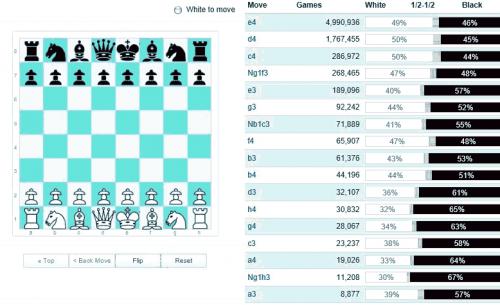
Look at that over 4 million games beginning with 1.e4. So how do we use it.
This is one way. Pick a future opponent. I’ve picked jrps33 simply because I
needed a name and went to the games in progress and that was top of the list.
So you enter the name and have them playing White.
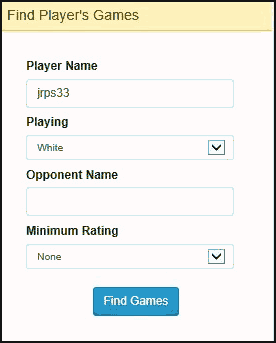
Then click on ‘Find Games and we get.

The top choice is 1.e4 (489 times) . Click on 1.e4 and we see:
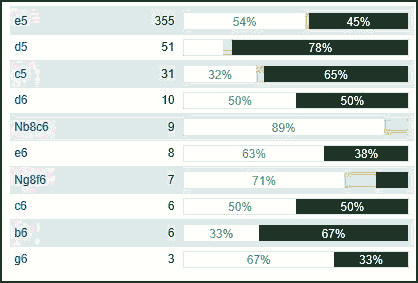
That after 1.e4 jrps33 has lost 78% of their games to 1..d5
(The Centre Counter/Scandinavian)
Now we look at what line is giving jrps33 trouble after 2.exd5 is it 2…Qxd5 or 2…Nf6.
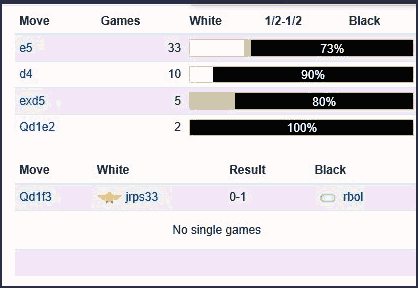
There is probably the cause of jrps33 run of bad luck v 1…d5.
the move 2.e5 which tends to give Black an easier game to play.
Ideally your White’s should show a better a result and get you into a
playable middle game. These stats are telling jrps33 2.e5 is not working .
(Use the Games Explorer to look at the 2.exd5 lines and take them on. )
So that is one way of using the database. Looking your opponent’s game to
see what is giving them trouble. Also look at your own games and you may
too unearth an opening line you play is going against you or you may discover
you have a very healthy plus against an opening or player you never knew you had.
Having said that about jrps33’s 2.e5 it may work if Black drifts into a position
where they cannot attack and undermine the advanced e-pawn Here is one of
jrps33 ‘s game , he won. I’m thinking tactics is more important than opening theory.
jrps33 - zeddola RHP 2013
I mentioned a Greek Gift Sacrifice. SilentKinght went to Greece for a holiday.
he sent me this picture of a game he played poolside (More of these please.)
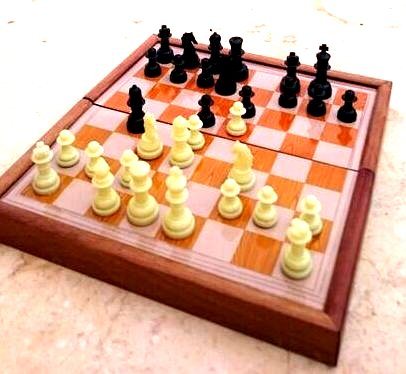
It’s White to play. All I had was the picture but I figured out the opening moves.

I do not know any Eccentric Bishops but I do have this study by S. Kaminer.
The clue is The Eccentric Bishop. White to play and win. I’ll give the answer after the next game.
So what is an Eccentric Bishop. This is an example of an eccentric Bishop move.
1. e4 e5 2. Nf3 Nc6 3. Bb5 Bb4
That’s odd. It came from Simon (Semyon) Alapin (1856-1923).
It appears as if the Bishop has skidded one square too far and landed on b4.
The idea, and it’s not bad it just looks eccentric, is to play a Cozio Defence.
1. e4 e5 2. Nf3 Nc6 3. Bb5 Nge7
That is a very solid though passive defence. 4.Bb4 is an attempt to get an active Cozio.
Let’s have a look at an RHP game and what happens when Black does not play Ne7.
squirrel0like0nuts - vOLTERA RHP 2012

The solution to the study by S. Kaminer.
It’s one them! I first saw it ages ago and have been itching to show it someone.
I can wait no longer. That someone is you. Play out this Bishop v Queen study.
That last try by Black to get a draw. Nobody would ever fall for that.
friartuck - hatfinch RHP 2010
Nobody would ever fall for that. Part II
kloubich - norburykingdom RHP 2013

